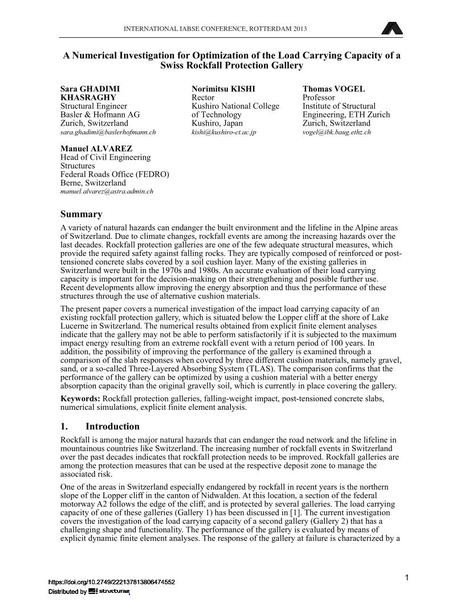A Numerical Investigation for Optimization of the Load Carrying Capacity of a Swiss Rockfall Protection Gallery

|
|
|||||||||||
Bibliografische Angaben
| Autor(en): |
Sara Ghadimi Khasraghy
Norimitsu Kishi Thomas Vogel Manuel Alvarez |
||||
|---|---|---|---|---|---|
| Medium: | Tagungsbeitrag | ||||
| Sprache(n): | Englisch | ||||
| Tagung: | IABSE Conference: Assessment, Upgrading and Refurbishment of Infrastructures, Rotterdam, The Netherlands, 6-8 May 2013 | ||||
| Veröffentlicht in: | IABSE Conference, Rotterdam, May 2013 | ||||
|
|||||
| Seite(n): | 134-135 | ||||
| Anzahl der Seiten (im PDF): | 8 | ||||
| Jahr: | 2013 | ||||
| DOI: | 10.2749/222137813806474552 | ||||
| Abstrakt: |
A variety of natural hazards can endanger the built environment and the lifeline in the Alpine areas of Switzerland. Due to climate changes, rockfall events are among the increasing hazards over the last decades. Rockfall protection galleries are one of the few adequate structural measures, which provide the required safety against falling rocks. They are typically composed of reinforced or post- tensioned concrete slabs covered by a soil cushion layer. Many of the existing galleries in Switzerland were built in the 1970s and 1980s. An accurate evaluation of their load carrying capacity is important for the decision-making on their strengthening and possible further use. Recent developments allow improving the energy absorption and thus the performance of these structures through the use of alternative cushion materials. The present paper covers a numerical investigation of the impact load carrying capacity of an existing rockfall protection gallery, which is situated below the Lopper cliff at the shore of Lake Lucerne in Switzerland. The numerical results obtained from explicit finite element analyses indicate that the gallery may not be able to perform satisfactorily if it is subjected to the maximum impact energy resulting from an extreme rockfall event with a return period of 100 years. In addition, the possibility of improving the performance of the gallery is examined through a comparison of the slab responses when covered by three different cushion materials, namely gravel, sand, or a so-called Three-Layered Absorbing System (TLAS). The comparison confirms that the performance of the gallery can be optimized by using a cushion material with a better energy absorption capacity than the original gravelly soil, which is currently in place covering the gallery. |
||||
| Stichwörter: |
numerische Simulationen
|
||||
